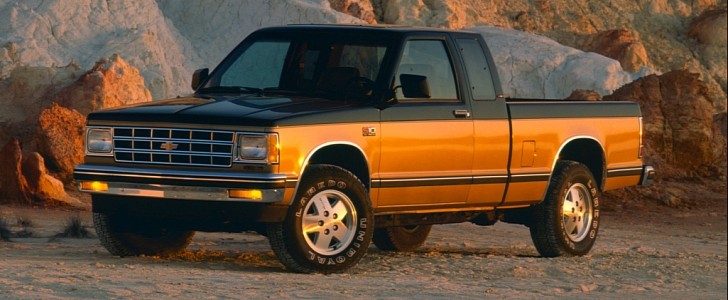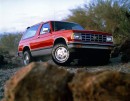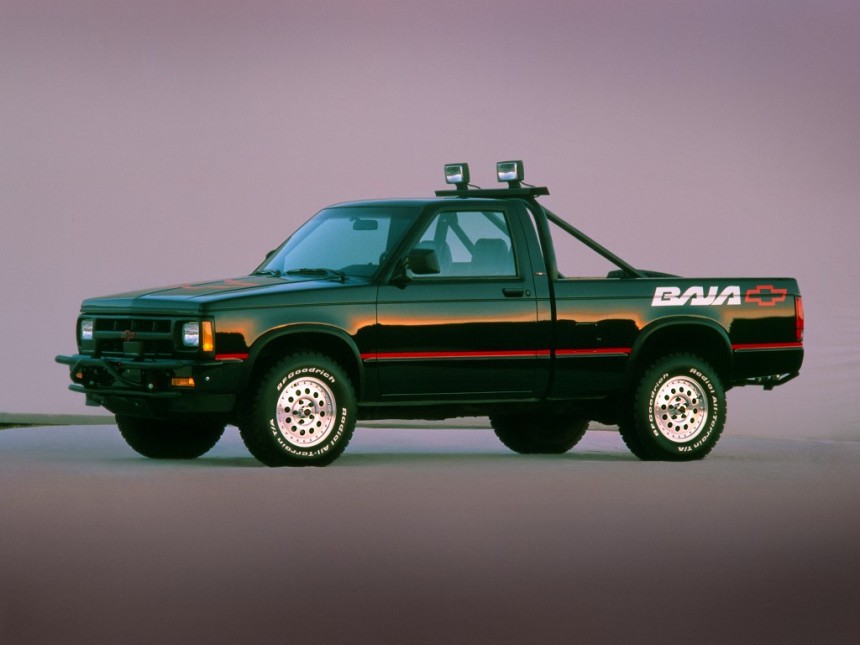Offered between 1972 and 1980, the first-generation Isuzu Faster was rebadged as the Chevrolet LUV in the United States of America as a response to Datsun and Toyota pickups as well as the Mazda-built Ford Courier. In 1981, General Motors decided to go solo with the S-10 series, the first domestic-built compact pickup from the Big Three in Detroit.
Introduced 40 years ago for the 1982 model year as the Malaise Era was coming to a close with the advent of electronic fuel injection and three-way cats, the S-10 was a little bit larger than its predecessor but considerably smaller than the C/K family of full-size pickup trucks. Only available with rear-wheel drive in the first year of production, the S-10 featured a 1.9-liter mill manufactured by Isuzu in Japan and a four-speed manual as standard.
Published in November of 1981, the brochure attached at the end of this article reveals that we’re dealing with a two-barrel carburetor, 82 horsepower at 4,600 revolutions per minute, and 101 pound-feet (137 Nm) of torque at 3,000 rpm. Offered with 6.0- and 7.5-foot beds, the quarter-ton truck could be had with a three-speed automatic tranny and a 2.8-liter V6 as well. Priced at $215 over the standard engine, the six-cylinder engine offered 110 ponies along with 148 pound-feet (201 Nm) while the four-pot used to retail at merely $6,270 (make that $18,920 after we adjust for inflation).
For the 1983 model year, the Golden Bowtie improved the breed with an extended cab, four-wheel drive, and a 2.0-liter option that also used a Rochester two-barrel downdraft carburetor to make 83 horsepower and 108 pound-feet (146 Nm) of torque. The original S-10 Blazer came out that year with a two-door body, while the four-door version followed in 1991.
Come 1984, a non-turbocharged diesel was added to the lineup with pretty bad output figures: 62 horsepower and 96 pound-feet (130 Nm) at 2,200 rpm from 2.2 liters. The S-10 was further treated with a sporty suspension for the regular cab 4x2 and a hydraulic clutch instead of a cabled clutch.
A 2.5-liter motor with throttle-body injection, a modernized instrument cluster, and redesigned S-10 emblems were the biggest changes for 1985. Come 1986, the 2.8-liter V6 added throttle-body injection as well. Under pressure from other automakers, Chevy decided to replace the V-belts with a more dependable serpentine belt system on the 2.5 and 2.8 in 1987.
The biggest improvement for 1988 came in the guise of a 4.3-liter V6 under RPO code LB4, rated at 160 horsepower and 230 pound-feet (312 Nm) of torque at 2,800 revs. The Greed Decade came to a close with anti-lock brakes, an electronic instrument cluster, and the somewhat rare Cameo appearance package. Somewhat rare as in 2,918 Cameos were sold in 1989.
Chevrolet improved the S-10 little by little until 1994, when the second generation launched on the same GMT325 platform as the original. General Motors kept the body-on-frame truck architecture in production until the early 2000s when the Detroit-based automaker switched to the GMT355.
Redesigned after more than a decade, the S-10 became more attractive with the help of a wraparound front grille and a sloping hood. Slightly larger than before, the compact pickup came with a 2.2-liter standard motor and a 4.3-liter option along with a five-speed stick shift and the 4L60-E automatic.
Daytime running lights and a driver-side airbag became standard in 1995, the year Chevrolet switched to the S-Series nomenclature. The 1996 extended cab gained an optional third door on the driver’s side, and come 1997, the core brand of GM rolled out the S-10 EV electric pickup truck.
By the end of 1998, the year Chevrolet switched back to the S-10 moniker, the peeps at GM produced a total of 492 units with two battery chemistries: lead-acid in 1997 and NiMH in 1998. The latter could get up to 90 miles (140 kilometers) on a full charge, which is pitiful in comparison to modern-day electric pickups. The GMC Hummer EV comes to mind, as do the Rivian R1T, Ford F-150 Lightning, and the polarizing Tesla Cybertruck.
Fast forward to 2001, and that’s when Chevrolet and GMC introduced the crew-cab option for the S-10 and Sonoma. A tachometer and air conditioning became standard in 2002, and not much happened in 2003, the penultimate year of the compact workhorse. For 2004, only the crew-cab 4x4 with the 4.3-liter V6 and torque-converter automatic were offered.
This is where the S-10 story ends for the U.S. market, but over in Brazil, Chevrolet continues to utilize the S10 nameplate for a mid-size pickup twinned with the Colorado. Both feature the GMT 31XX platform, which replaces the GMT355 of the first-gen Colorado and Canyon.
Published in November of 1981, the brochure attached at the end of this article reveals that we’re dealing with a two-barrel carburetor, 82 horsepower at 4,600 revolutions per minute, and 101 pound-feet (137 Nm) of torque at 3,000 rpm. Offered with 6.0- and 7.5-foot beds, the quarter-ton truck could be had with a three-speed automatic tranny and a 2.8-liter V6 as well. Priced at $215 over the standard engine, the six-cylinder engine offered 110 ponies along with 148 pound-feet (201 Nm) while the four-pot used to retail at merely $6,270 (make that $18,920 after we adjust for inflation).
For the 1983 model year, the Golden Bowtie improved the breed with an extended cab, four-wheel drive, and a 2.0-liter option that also used a Rochester two-barrel downdraft carburetor to make 83 horsepower and 108 pound-feet (146 Nm) of torque. The original S-10 Blazer came out that year with a two-door body, while the four-door version followed in 1991.
Come 1984, a non-turbocharged diesel was added to the lineup with pretty bad output figures: 62 horsepower and 96 pound-feet (130 Nm) at 2,200 rpm from 2.2 liters. The S-10 was further treated with a sporty suspension for the regular cab 4x2 and a hydraulic clutch instead of a cabled clutch.
A 2.5-liter motor with throttle-body injection, a modernized instrument cluster, and redesigned S-10 emblems were the biggest changes for 1985. Come 1986, the 2.8-liter V6 added throttle-body injection as well. Under pressure from other automakers, Chevy decided to replace the V-belts with a more dependable serpentine belt system on the 2.5 and 2.8 in 1987.
Chevrolet improved the S-10 little by little until 1994, when the second generation launched on the same GMT325 platform as the original. General Motors kept the body-on-frame truck architecture in production until the early 2000s when the Detroit-based automaker switched to the GMT355.
Redesigned after more than a decade, the S-10 became more attractive with the help of a wraparound front grille and a sloping hood. Slightly larger than before, the compact pickup came with a 2.2-liter standard motor and a 4.3-liter option along with a five-speed stick shift and the 4L60-E automatic.
Daytime running lights and a driver-side airbag became standard in 1995, the year Chevrolet switched to the S-Series nomenclature. The 1996 extended cab gained an optional third door on the driver’s side, and come 1997, the core brand of GM rolled out the S-10 EV electric pickup truck.
By the end of 1998, the year Chevrolet switched back to the S-10 moniker, the peeps at GM produced a total of 492 units with two battery chemistries: lead-acid in 1997 and NiMH in 1998. The latter could get up to 90 miles (140 kilometers) on a full charge, which is pitiful in comparison to modern-day electric pickups. The GMC Hummer EV comes to mind, as do the Rivian R1T, Ford F-150 Lightning, and the polarizing Tesla Cybertruck.
Fast forward to 2001, and that’s when Chevrolet and GMC introduced the crew-cab option for the S-10 and Sonoma. A tachometer and air conditioning became standard in 2002, and not much happened in 2003, the penultimate year of the compact workhorse. For 2004, only the crew-cab 4x4 with the 4.3-liter V6 and torque-converter automatic were offered.
This is where the S-10 story ends for the U.S. market, but over in Brazil, Chevrolet continues to utilize the S10 nameplate for a mid-size pickup twinned with the Colorado. Both feature the GMT 31XX platform, which replaces the GMT355 of the first-gen Colorado and Canyon.



























